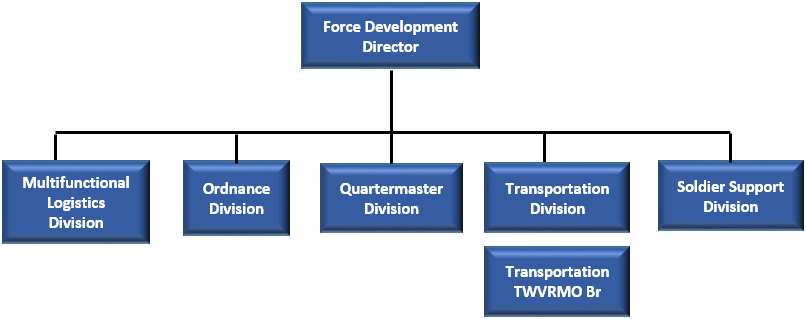Home > Organizations > General Staff > Fielded Force Integration Directorate > Force Development Directorate
Force Development Directorate (FDD)
Mission
Develops sustainment organizational and force structure requirements for the following functions: human resource, finance, field support, maintenance, ammunition storage and supply, and Explosive Ordnance Disposal, supply storage and distribution; retrograde; petroleum supply, distribution and services; water purification and distribution; mortuary affairs; aerial delivery; field services, force provider, field feeding, motor transport operations, Army watercraft, movement control, terminal operations, and multifunctional sustainment organizations within the operational Army.
Organization
FDD consists of five Divisions: Multifunctional (MF) Division; Quartermaster (QM) Division; Transportation (TC) Division; Ordnance (OD) Division; and Soldier Support Division (SSD). Each division consists of two teams: Force Structure Team; Force Design Team.
Functions
- Designs and integrates all Sustainment designs, force structure, and Table of Organization and Equipment (TOE) documentation actions to include the development of Rules of Allocation for TOEs.
- Develops Unit Reference Sheets (URS) for Sustainment designs that are used by documenters to facilitate in TOE development.
- Identifies organizational and force structure solutions to resolve or mitigate gaps in sustainment capability.
- Provides analysis and data to CASCOM concerning force structure and integration through the Total Army Analysis (TAA) and force design update (FDU) processes.
- Develops sustainment TOE and manpower requirements for the U.S. Army Force Management Support Agency (USAFMSA) validation and approval.
- Reviews Manpower Requirements Criteria (MARC) schedules, questionnaires, and revision documents for functional adequacy.
- Coordinates and supports sustainment force design issues with the HQDA G-3 organizational integrators.
- Develops organizational sustainment solutions for all Army Standard Requirements Codes.
- Reviews Basis of Issue Plans, as well as Feeder Data, and LIN Validation as it pertains to Strategic Portfolio (SPAR), for materiel systems and determines organizational requirements.
- Integrates Army emerging Sustainment concepts through operational and organizational (O&O) concepts and Army modernization into Sustainment force structure designs. The integration of existing and emerging O&Os support the development of i.e., doctrinal, organizational, training, materiel, leadership, facilities, and policies (DOTMLPF-P).
- Reviews, analyzes, and evaluates appropriate operational concepts and O&Os, regulations, doctrinal literature, studies, threat materials, reports of a scientific and technological nature, etc. to determine impact on Army Sustainment organizations, functions, and systems.
- Integrates joint (U.S. services) and combined (other nations) operational concepts for wartime support services.
- Provides sustainment force structure assistance and expertise to DoD, joint agencies, HQDA stakeholders, AMC, FORSCOM, AFC, as well as TRADOC through CAC and its subordinate Centers of Excellence, and Army service component commands.
FDD Divisions Responsibilities
Multifunctional Division:
Manages Standard Requirements Code (SRC) 63 (Army's Multifunctional Logistics Headquarters Organizations) in support of FDD core functions.
MF is responsible for Management of Army of CL VIII Medical Logistics, and is the directorate primary interface with United States Army Special Operations Command (USASOC).
Additionally, MF includes the Force Structure Integration (FSI) Branch, which is a special branch within the Division that is responsible for determining the force designs and force structure requirements for Army multifunctional logistics organizations.
Beyond its MFD responsibilities in providing support to FDD core functions, FSI provides the following:
- Develops, adjusts, and coordinates Sustainment unit allocation rules and workloads in the (FORGE) models based on Sustainment TOEs and emerging concepts and doctrine for support.
- Coordinates development, maintenance and update of Qualitative and Quantitative Personnel Requirements Information (QQPRI).
Transportation Division:
Manages Standard Requirements Code (SRC) 55 (Motor Transport Operations, Army Watercraft, Movement Control, Terminal Operations) in support of FDD core Functions.
Additionally, TC includes the Tactical Wheeled Vehicle Requirements Management Office (TWVRMO) Team, who is the TRADOC single manager of TWV requirements. FDD, through TC, manages the TRADOC process for validating the form, fit and function applicability of Tactical Wheeled Vehicle (TWV), which ensures that TWV Minimum Mission Essential Wartime Requirements (MMEWR) are adequately stated, justified and documented in Army Force Structure Requirement Documents, in support of Capabilities Developers. The Team also validates TWV requests through the DA TOE Organizational Requirements Documentation Approval Briefings and TDA Equipment Review and Validation Board; and conducts TWV requirements analysis/mobility studies to support TWV modernization and force structure decisions.
Quartermaster Division:
Manages Standard Requirements Code (SRC) 10 (Petroleum Support and Services, Water Purification and Distribution, Mortuary Affairs (MA), Aerial Delivery (AD), Field Services, and Force Provider Logistics Support to the Soldier) in support of FDD core functions. Additionally, QM represents the Quartermaster General (QMG) in both TAA and QM force structure actions.
Ordnance Division:
Manages Standard Requirements Codes (SRCs) 09 and 43 (Ammunition Storage and Supply, Explosive Ordnance Disposal, and Maintenance) in support of FDD core Functions.
Soldier Support Division:
Manages Standard Requirements Codes (SRC) 02, 12 and 14 (Army Bands, Human Resources (HR), and Financial Management (FM)) in support of FDD core functions.
Represents Soldier Support Institute (SSI) at appropriate conferences, meetings, workshops, in process reviews (IPRs), study advisory groups (SAGs), etc.
Identifies, plans, develops, researches, prepares and presents decision papers, and coordinates existing and emerging FM and HR operational and organizational (O&O) and operational concepts.
Develops joint (U.S. services) and combined (other nations) operational concepts for wartime personnel support services.
Organizational Chart

